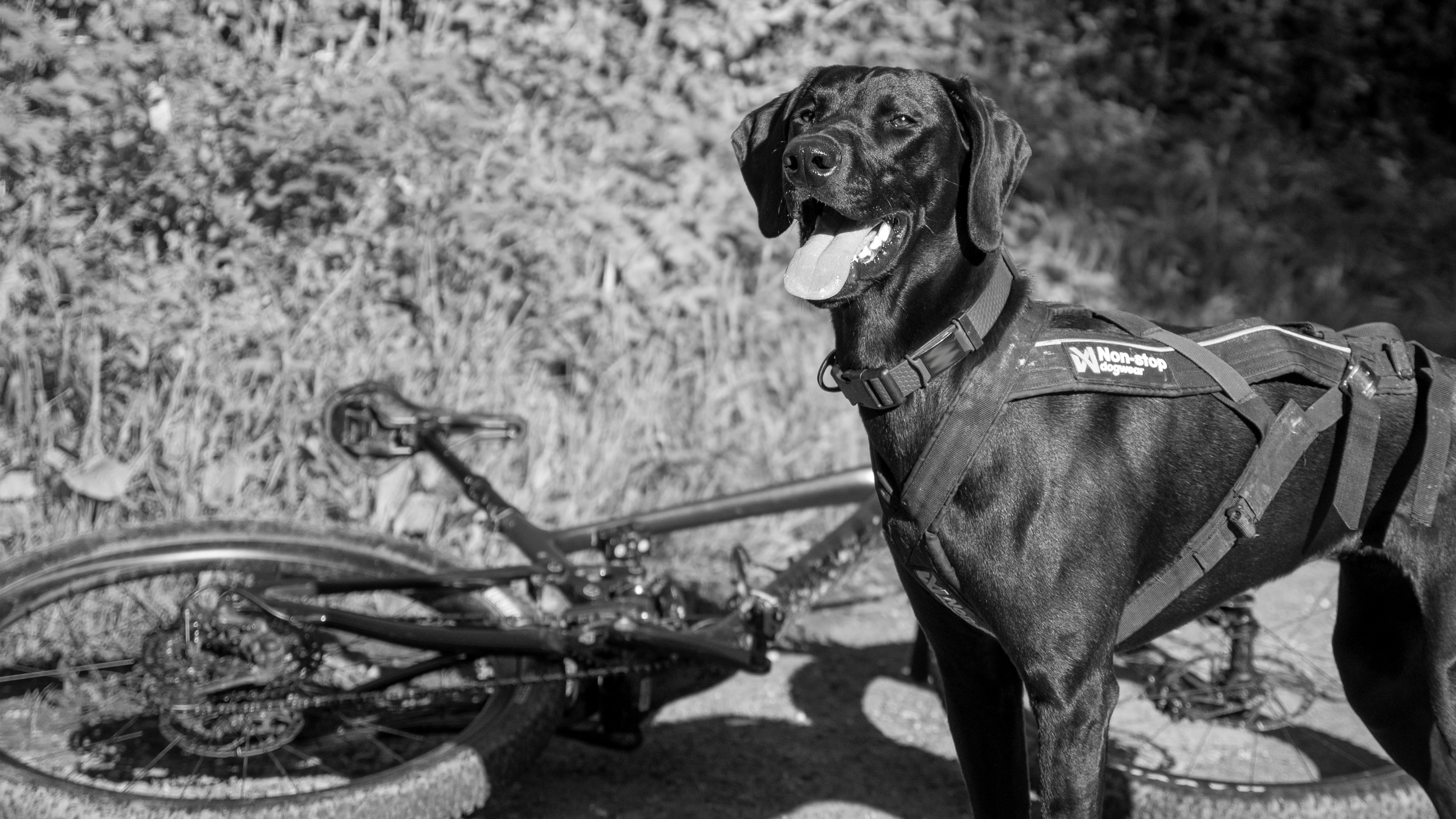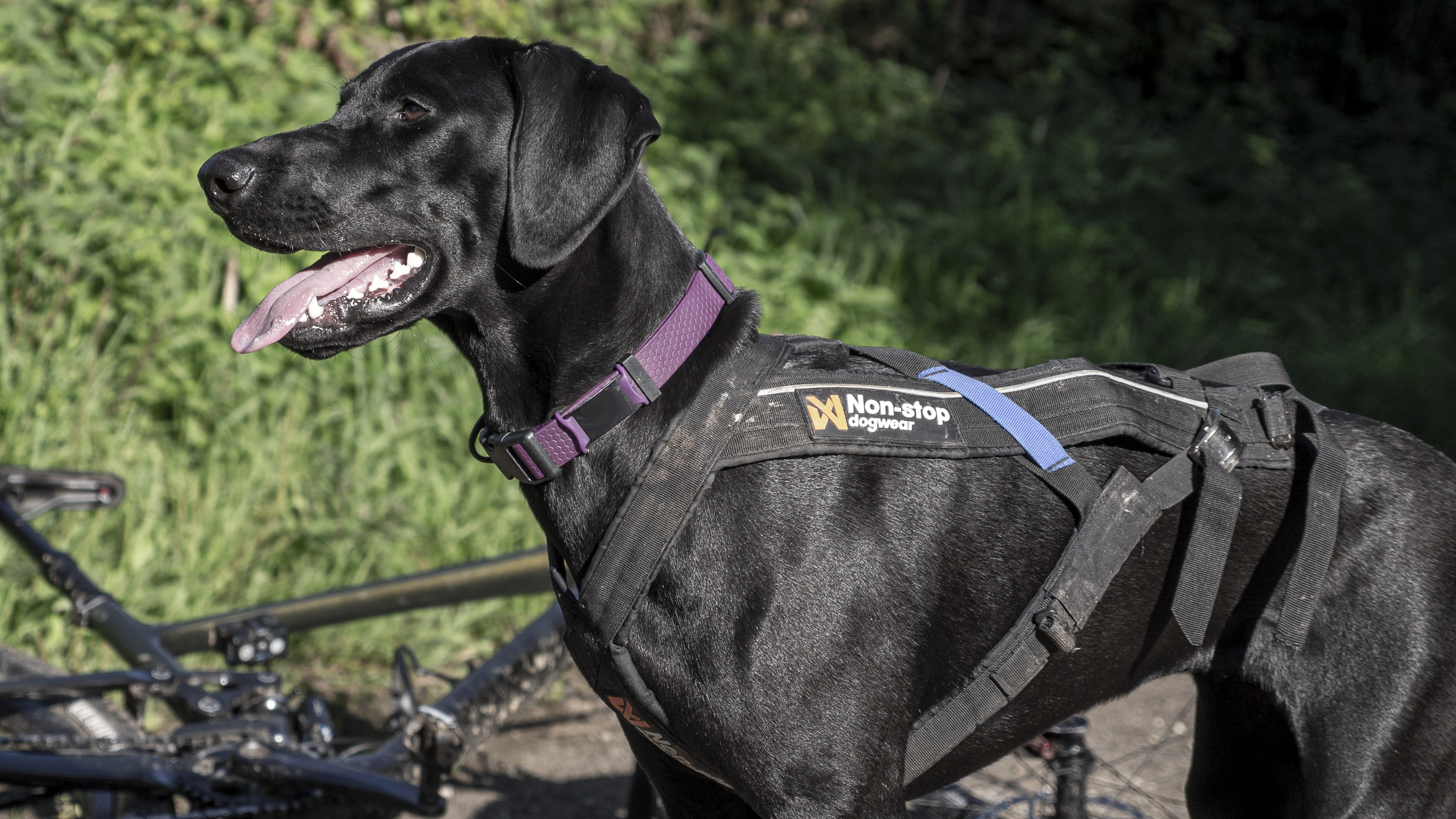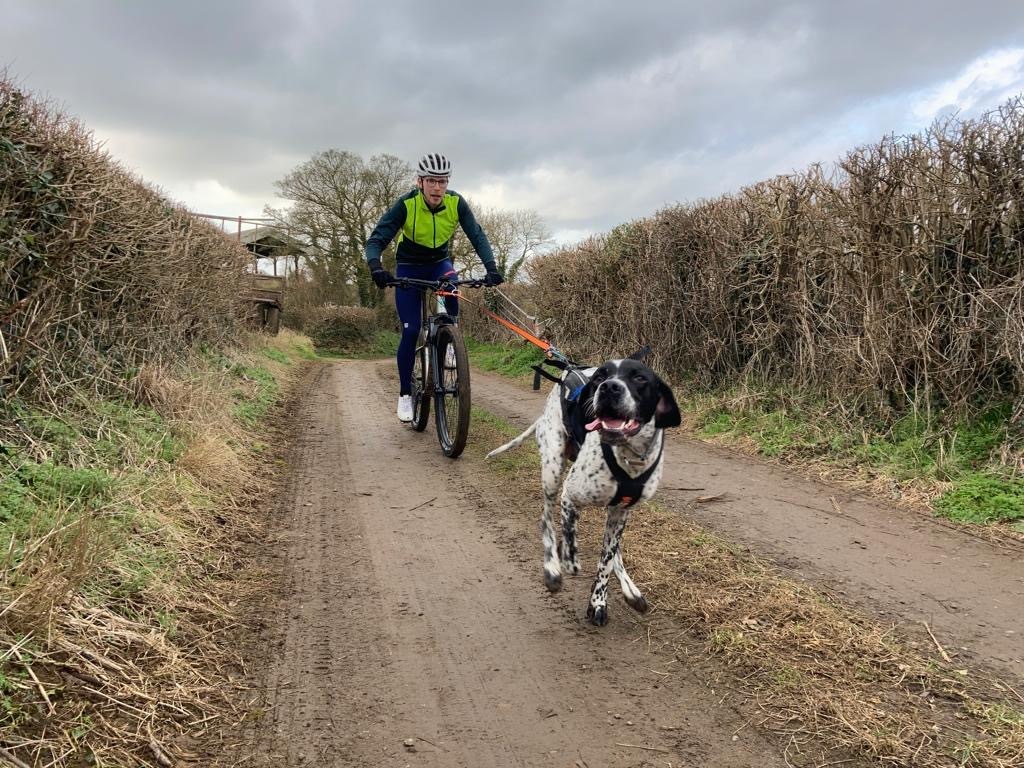
When I tell my cycling friends and colleagues that I've recently started bikejoring with my dog, it's almost always met with a blank expression. Far from a mainstream cycling discipline, bikejoring is fun, fast-paced, and even faster-growing, but what exactly is it?
Bikejoring (pronounced bike-jore-ing) is a form of off-road cycling in which a dog (or two) run in front of a bike, attached via a bungee line and a special harness designed to allow the dog to comfortably and safely pull.
It's roots lie in the commonly-snow-based activity of mushing, which itself refers to using dogs to pull the 'musher' on their sled or wheeled rig. Picture a pack of huskies pulling sleds through snow and you're on the right lines.
In the most simple terms possible, bikejoring is that, but with fewer dogs, and a mountain bike instead of the sled. Closely related is the sport of canicross, which involves cross-country running instead of mountain biking, and skijoring which as you may have worked out, replaces the bike with skis.
It might still be widely unknown, but it's a recognised sport with two international governing bodies, the International Canicross Federation (ICF), and the International Federation of Sleddog Sports (IFSS) as well as national, continental and world championships. It isn't governed by cycling's governing body, the UCI (Union Cycliste Internationale), so it wasn't incorporated into the Glasgow multi-disciplinary world championships, but in some instances such as equipment restrictions, the rules do borrow from the UCI.
Is bikejoring safe?
In a word, yes. Bikejoring is safe for both you and your dogs.
Of course, like any form of cycling, this assumes it is being done in a safe manner, on a safe and suitable course, with the correct equipment, all of which I will explain in more detail throughout this feature.
We're in no way affiliated, but equipment brand NonStop has an excellent resource on additional bikejoring safety tips for more on this subject.

Bikejoring equipment
Bikejoring bike
You'll need a bike that can handle riding off road. The type of bike you choose will depend on the terrain you choose to tackle and your proficiency handling it. If you're unsure here, a cross country mountain bike is a safe bet.
A hardtail would be my recommended choice for most riders, but full suspension is recommended for those with bigger and faster dogs, or those who want to progress to more technical terrain. I have recently been using a Giant Anthem 29er full suspension bike, but have previously used a Kona Honzo hardtail and a Specialized Crux gravel bike successfully with my dog.
It's important to ensure your brakes are in good working order in case your dog misses a turn or stops unexpectedly (did someone say squirrel?). You should also wear a helmet - for which we have a list of the best budget bike helmets here. If you think you might want to compete with your dog, the ICF, which sets out the rules for most competitive events, mandates a "mountain bike as defined by the UCI," meaning flat handlebars will be required.

Bikejoring harness
Pulling-specific harnesses are designed to allow your dog the total freedom of movement and breathing even when pulling. There are various suitable harnesses available from brands such as NonStop Dogwear as shown above, Zero DC, Sledwork and more. They are all approximately the length of the dog wearing it, spreading the pressure evenly and comfortable across the dog's chest, with the line attaching to the most rearward point near the tail.
You should not bikejor with your dog without using a well-fitting pulling-specific harness, as this can be dangerous.

Bikejoring line
Connecting the dog to the bike is a bungee line or leash. Most are around 2.8m in length when stretched, allowing the dog to be a good safe distance from the front wheel. One end is looped to wrap around the bike's head tube and the other end features a karibiner-style clip to easily but securely attach to the harness.

Bikejoring antennae
At times, the line will inevitably become slack, and the antennae prevents it from becoming tangled in the front wheel. It protrudes out above the front wheel, and your line feeds through a loop at the end, holding it above the front wheel rather than letting it droop down and become tangled. While it is possible to bikejor without an antennae, it is much safer with.
Anything else?
It's recommended that you wear a helmet, for obvious reasons, gloves to protect your hands, and glasses. Dogs have a habit of flicking up a lot of mud from the trail into your face!
How to train your dog to bikejor
With the equipment prepared, the next thing is to introduce your dog and teach them the game. At first, most dogs will have no idea what you're asking them to do, they may even be fearful of the bike, so introduce them to everything slowly and in a positive, rewarding way.
It's recommended that you first introduce your dog to pulling sports with canicross, rather than straight onto the bike, as this offers more control at slower speeds.
Before you start, it's also important to teach them the basic commands. Many mushers use the terms 'gee' and 'haw' representing 'right' and 'left' respectively, with 'on by' meaning to continue straight, 'easy' to mean slow down, and 'woah' to stop. Of course, as long as both you and your dog understand your commands, you can use whatever verbal cues you want.
A great way to introduce a dog to bikejoring is to join a club or find fellow bikejorers or canicrossers to run with. You might find that canicross clubs are more abundant and easier to find. That was certainly the case for me, with one of my local clubs Wessex Canicross running regular 'beginner bikejor' rides. Once your dog sees other dogs running in front of their owners, they should instinctively follow suit. Once they get the hang of it, you can then try leading the group to teach your dog to bikejor alone (well, without needing someone in front to follow).
If you don't have a club nearby, you can seek help via dedicated bikejoring groups on Facebook. Given the small scale of the sport, these groups are often wide-reaching with members from around the world with a depth of knowledge and advice.

Who can bikejor?
One of the great things about bikejoring is that there are no restrictions as to who can get involved. No matter if you're an experienced mountain biker, someone who occasionally rides with your family, or you haven't ridden a bike since you were a child. As long as you know how to ride a bike, and you have a dog – or dogs – you're in the club.
Bikejoring dogs
Can mine get involved?
Just like with the human, there's no limit or restriction as to the type, gender or size of dog that can enjoy bikejoring. It can be a physically demanding sport for the dog, so in order to let them grow fully and develop properly, the rules state they shouldn't bikejor until they are at least 18 months of age. From this point onwards, any dog big or small can bikejor.
As you can probably imagine, some dogs will be better suited to the sport than others. Bigger, high-energy dogs such as working or hunting breeds, such as hounds and huskies, will be able to run faster and farther than smaller dogs, but there is no minimum distance requirement to having fun. In competitive events, purpose-bred dogs known as Greysters (German Shorthaired Pointer x Greyhound) or Eurohound (German Shorthaired Pointer x Alaskan Husky) are common.

Maximum number of dogs for bikejoring?
Competitively, both one-dog and two-dog bikejoring are categorised officially, but that's not to say you couldn't run more if you and your dogs were trained for it. Safety is paramount, of course, so just don't do anything that could put you or your dogs in harm's way.
Where can I bikejor?
Bikejoring should be performed off-road, primarily because the hard impact of running on paved ground can be damaging to the dog. Easy trails, fields and forest tracks can make for excellent terrain - anywhere you'd comfortably take a gravel bike.
According to the ICF rulebook, bikejor races are performed over a distance of between 5 and 7 kilometres for 'long' course races, or up to 3km for short course races. These are held primarily on closed off-road trails. However, the distance you cover will depend on the fitness of your dog. Beginner dogs will need working up to longer distances slowly - my dog was put through the popular 'Couch to 5K' program and spent a year competing in canicross with my fiancee, occasionally adding in longer bikejor runs progressing slowly up in distance. His longest so far is 12km, with stops, and he was pulling strongly for the full distance.

Bikejoring temperatures
Unfortunately for fairweather cyclists, bikejoring is not a summer sport. The dogs' welfare is paramount, and they can be very quick to overheat when exercising in warm weather, so temperature and humidity should be closely monitored.
For competitions, the IFSS rules state that normal bikejor competition can only take place where temperatures are less than 16C/61F with humidity below 85%. Where temperatures exceed this, the race may be shortened, delayed, or cancelled depending on the conditions, with anything over 22C/72F being the maximum limit.
How fast is bikejoring?
Bikejoring with a strong, well-trained dog is like riding an electric mountain bike with the motor permanently engaged uphill, downhill, and around corners, so it can be fast-going.
World Championship races are often covered at an average of around 30km/h, with the fastest dogs able to run at up to 50km/h at points. Of course, bikejoring doesn't need to be a competitive affair, it can be enjoyed as a hobby at any pace. Your speed will match your own fitness, your bike handling skills, and the speed of your dog.
Why should I start bikejoring?
Bikejoring is an excellent way to meet a dog's need for exercise. It's a highly physical sport and a great way to help them burn off all those treats. It can also be a great way to provide mental stimulation. If your dog likes to run, then bikejoring can be the perfect tool to help avoid destructive behavior, boredom, and even stress.
And finally, in bikejoring, both rider and their dog(s) become a single team and it's an excellent way to build a bond.








